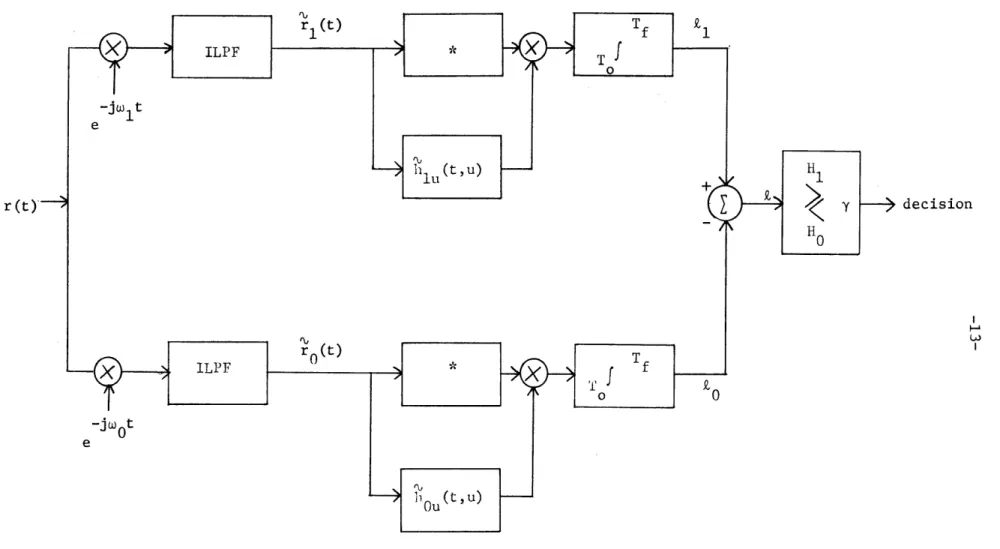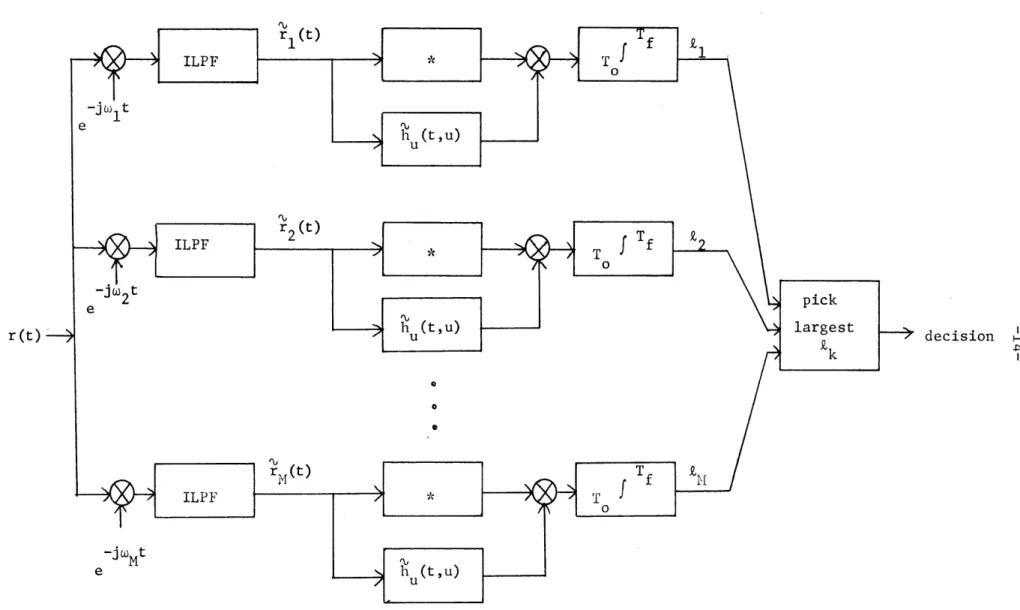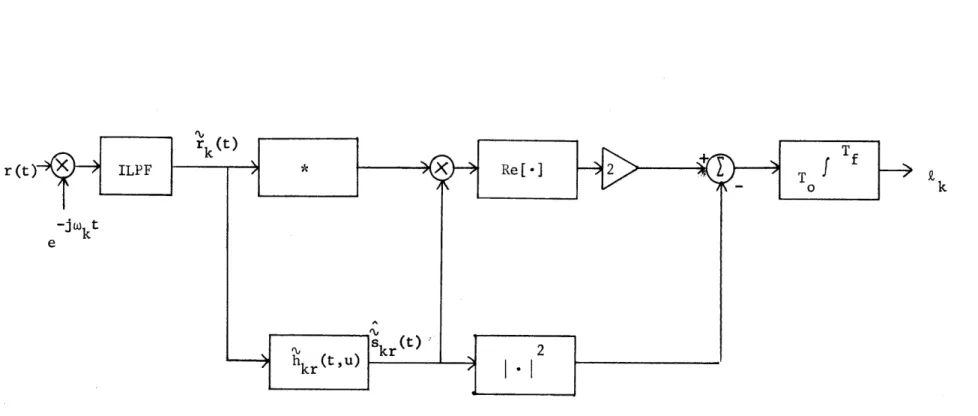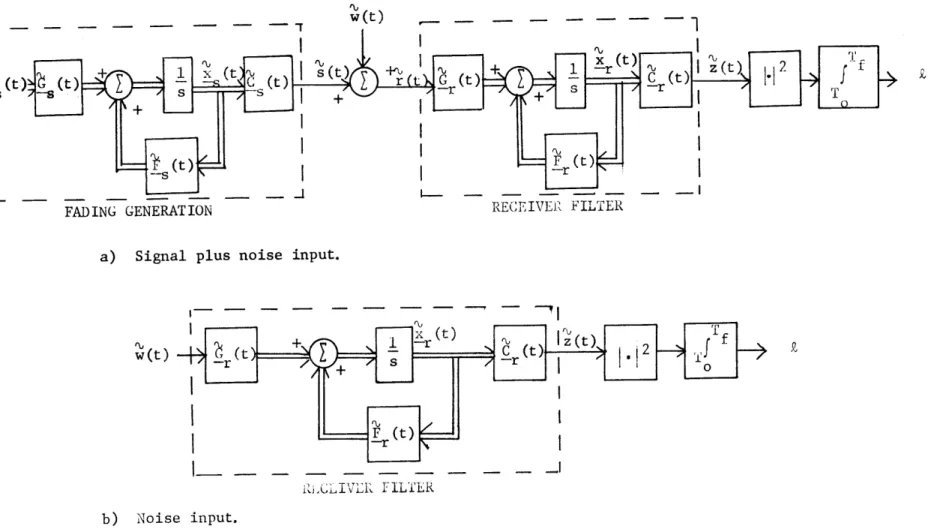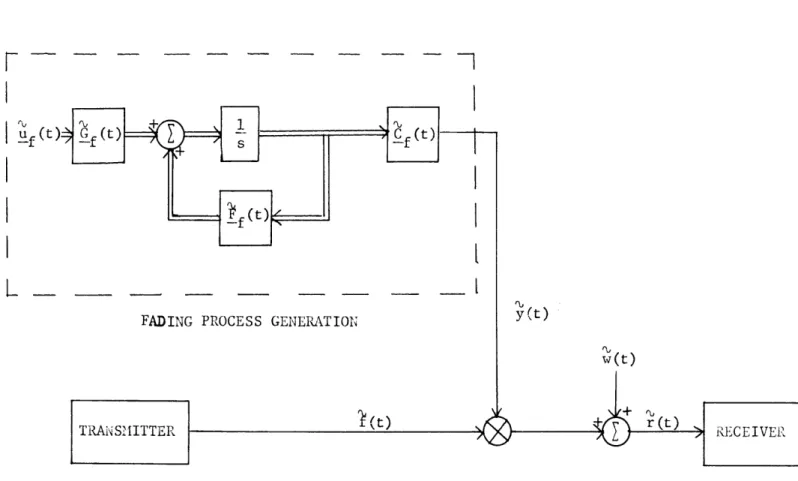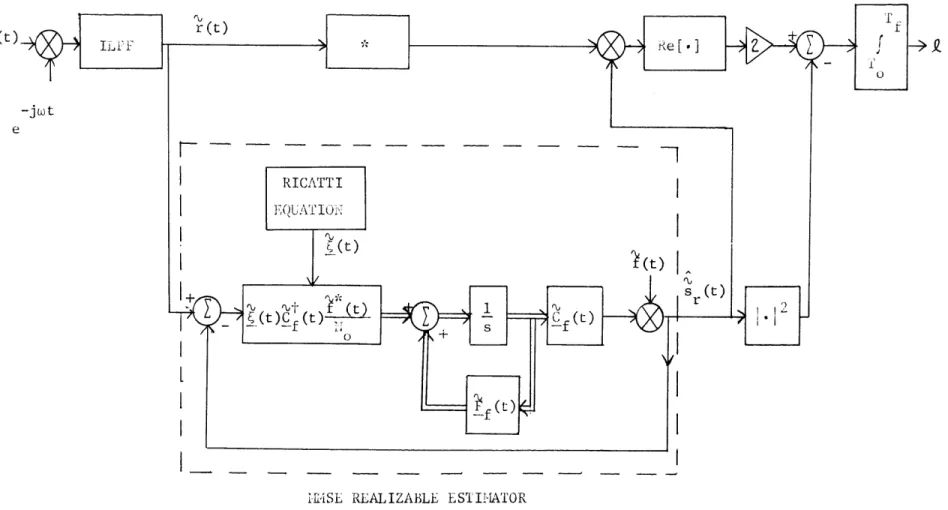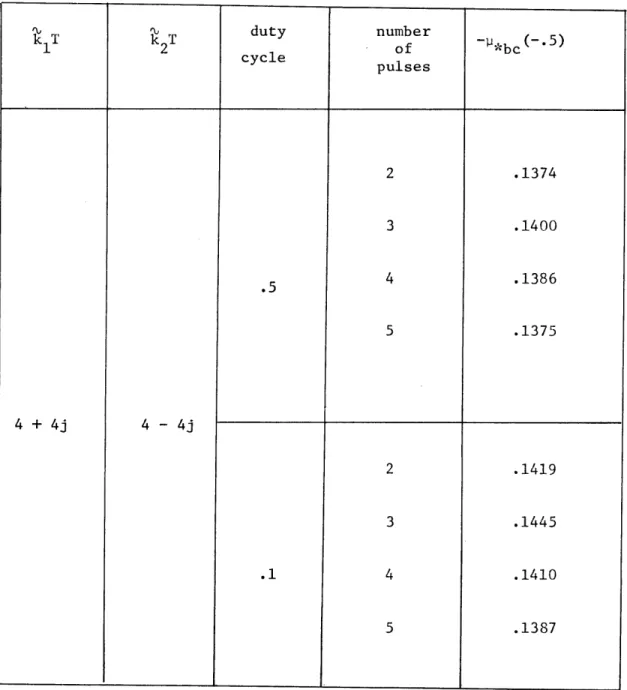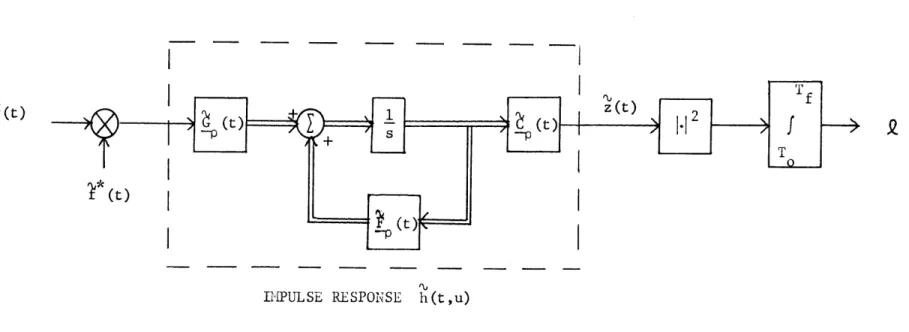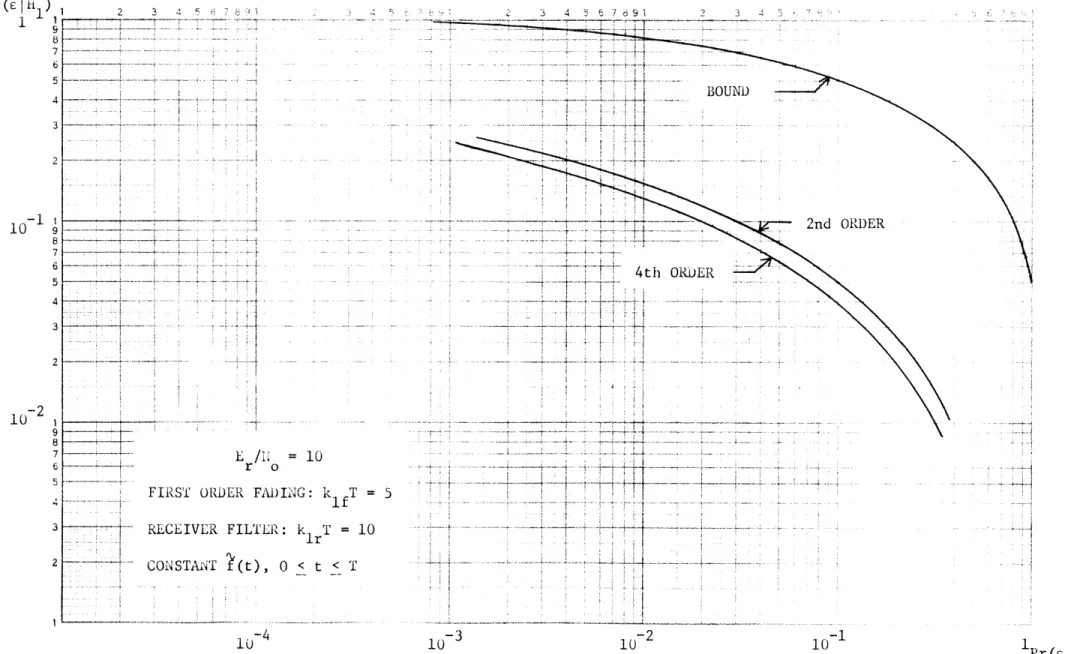DISTRIBUTED-PARAMETER STATE-VARIABLE TECHNIQUES APPLIED TO COMMVUNICATION OVER DISPERSIVE CHANNELS
by
RICHARD ROBERT KURTH
B.S., Massachusetts Institute
(1965)
M.S., Massachusetts Institute (1965)
E.E., Massachusetts Institute
(1968)
of Technology
of Technology
of Technology
SUBMITTED IN PARTIAL FULMFIIDMENT OF THE REQUIREMEINTS FOR THE DEGREE OF
DOCTOR OF SCIENCE at the
MASSACHUSETTS INSTITUTE OF TECHNOLOGY
June, 1969
Signature of Author
Department of Electrical Engineering, May 16, 1969
Certified by
The s Supervisor Accepted by
dc-Chairman~- Departmental Committee on Graduate Students
Archives
ohs.
Mrs. rf7tJUL
11
1969
-;JSRAiE *
DISTRIBUTED-PARAMETER STATE-VARIABLE TECHNIQUES APPLIED TO COMMUNICATION OVER DISPERSIVE CHANNELS
by
RICHARD ROBERT KURTH
Submitted to the Department of Electrical Engineering on May 16, 1969 in partial fulfillment of the requirements for the degree of Doctor of Science.
ABSTRACT
This thesis considers the problem of detecting known narrowband signals transmitted over random dispersive channels and received in addi-tive white Gaussian noise. Methods for calculating error probabilities and performance comparisons between optimum and suboptimum receivers are presented for doppler-spread, delay-spread, and doubly-spread channels.
The doppler-spread channel is assumed to have a finite state-variable representation. Asymptotic expressions for the error probabili-ties of suboptimum receivers are derived in terms of the semi-invariant moment-generating functions of the receiver decision statistic. The per-formance of two suboptimum receivers, a filter-squarer-integrator and a sampled correlator followed by square-law detection, come within one or two dB of the optimum receiver performance in a number of examples.
The delay-spread channel is related to the doppler-spread model by time-frequency duality.. Two suboptimum receiver structures are
sug-gested for the delay-spread channel: a two-filter radiometer, and a bank of delayed replica correlators followed by square-law detection. A di-rect method for finding the performance of the optimum and these subopti-mum receivers is given which is convenient for transmitted signals and
scattering distributions with finite durations. The suboptimum receiver performance is shown to be close to optimum in several examples.
A distributed-parameter state-variable model is given for the doubly-spread channel. It is a linear distributed system whose dynamics are described by partial differential equations and whose input is a dis-tributed, temporally white noise. The model is specialized to the case of stationary, uncorrelated scattering, and the class of scattering func-tions which can be described by the model are given. The realizable minimum mean-square error estimator for the distributed state vector in
the channel model is used to construct a realizable optimum detector. A by-product of the estimator structure is a partial differential equation
reduces the distributed model to a finite state system.
mate model is compared with a tapped delay line model for the channel. The performance of the optimum receiver is computed for an example. The technique for finding the optimum receiver error probabilities is use-ful for arbitrary signals and energy-to-noise ratios, and for a large class of doubly-spread channel scattering functions.
Finally, several suboptimum receivers for the doubly-spread chan-nel are considered. It is shown that their performance can be found by the methods used to obtain the optimum receiver performance.
THESIS SUPERVISOR: Harry L. Van Trees
TITLE: Associate Professor of Electrical Engineering
-ACKNOWLEDGEMENT
I wish to acknowledge the patient supervision of Professor Harry L. Van Trees. His guidance and encouragement during the course of my studies is deeply appreciated.
I would also like to thank Dr. Robert Price for his interest and comments. His original work on the dispersive channel communication problem has been a continual inspiration.
The readers of my thesis, Professors Robert S. Kennedy and Arthur B. Baggeroer have provided many helpful suggestions. The work of Dr. Lewis Collins has been valuable in the course of the re-search. Professor Donald Snyder and Dr. Ted Cruise have provided stimulating discussions.
The thesis research was supported by the Joint Services Elec-tronics Program of the Research Laboratory of Electronics. The compu-tations were performed at the M. I. T. Computation Center. Mrs. Enid Zollweg did an excellent job typing the thesis.
___
Chapter II. Asymptotic Error Probability Expressions for the Detection of Gaussian Signals in
Gaussian Noise 24
A. Bounds on and Asymptotic Expressions for Binary
Detection Error Probabilities 26
B. Error Probability Bounds for ýM-ary Orthogonal 35
Communication
C. Moment-Generating Functions for Optimum Receivers 43
D. Moment-Generating Functions for
Filter-Squarer-Integrator Receivers 47
E. Homent-Generating Functions for Quadratic Forms 55
F. Summary 58
Chapter III. Detection of Known Signals Transmitted Over
Doppler-Spread Channels 60
A. The Doppler-Spread Channel Model rn
B. The Optimum Receiver and its Performance 65
C. A Filter-Squarer-Integrator Suboptimum Receiver 80
D. A Correlator-Squarer-Sum Suboptimum Receiver 97
E. Summary 108
Chapter IV. Detection of Known Signals Transmitted over
Delay-Spread Channels 110
A. The Delay-Spread Channel Model 110
B. Duality and Doppler-Spread Channel Receivers 114
C. A Series Technique for Obtaining the Optimum
Receiver Performance for the Delay-Spread Channel 130
D. A Two-Filter Radiometer Suboptimum Receiver for
the Delay-Spread Channel 142
E. A Correlator-Squarer-Sum Suboptimum Receiver for
the Delay-Spread Channel 147
F. Summary 155
Chapter V. A Distributed-Parameter State-Variable Model for
Known Signals Transmitted over Doubly-Spread
Channels 157
--5-.
-6-A. The Doubly-Spread Channel:A Scattering Function
Model 158
B. A Distributed-Parameter State-Variable Channel
M11odel 162
C. A Realizable Detector and its Performance 172
D. A Modal Technique for Finding the Optimum
Receiver Performance 179
E. Optimum Receiver Performance: An Example 190
F. Summary 205
Chapter VI. Suboptimum Receivers for the Doubly-Spread Channel 207
A. A Distributed Filter-Squarer-Integrator
Suboptimum Receiver 208
B. A Correlator-Squarer-Sum Suboptimum Receiver 223
C. Summary 231
Chapter VII. Conclusion 235
Appendix I. A System Reliability Function for
Filter-Squarer-Integrator Receivers, M-ary Orthogonal Communication 244
Appendix II. The Optimum Receiver for a Delay-Spread Channel
Truncated Series Model 262
Appendix III. 'Minimum Mean-Square Error Estimation of
Distributed-Parameter State-Vectors 268
References 275
Biography 279
CHAPTER I
INTRODUCTION
An appropriate model for many detection and communication problems is one that describes the received waveform as the sum of a
signal term which is a Gaussian random process and a noise term which is also Gaussian. For example, in sonar and radar detection a known
signal is transmitted and may be reflected by a target. If the target
is not a point reflector of constant intensity, the received waveform can be characterized as a random process with properties that are related to the transmitted signal and the target scattering mechanism. Signals received after transmission over certain communication channels often
exhibit a similar random behavior. Such channels include underwater
acoustic paths, orbiting dipole belts, chaff clouds, and the tropo-sphere. The Gaussian signal in Gaussian noise model is also appli-cable in many situations which do not involve the initial transmission of a known waveform: passive acoustic detection of submarines, the discrimination between various types of seismic disturbances, or the detection of extraterrestial radio sources.
The optimum reception of Gaussian signals in Gaussian noise
has received considerable attention [1-8]. Van Trees [8] contains
a thorough discussion of optimum receivers, their realization, and performance evaluation for a wide class of Gaussian signal in Gaussian noise detection problems. A familiarity with these results is assumed here.
formulated as a binary hypothesis test. With r(t) denoting the re-ceived waveform, the two hypotheses are
H1 : r(t) = sl (t) + w(t),
T < t < T (1.1)
H0 : r(t) = s0 (t) + w(t), 0 f
The observation interval is [T ,Tf] and the signals Sk(t) are sample
functions of zero-mean, narrowband Gaussian random processes. That is,
the Sk(t) can be written in terms of their complex amplitudes as
jNJ) t Jakt
sk(t) = /2Re[s (t) e ], k = 0,1 (1.2)
with covariance functions
E[s k (t) s k (u)] = K(t,u)
(1.3)
E[s k (t) s k (u)] = 0•
jWk(t-u)
E[s(t)s(u)] = K (t,u) = Re[k (t,u)e (1.4)
k Sk
The superscript indicates complex conjugation and E[.] expectation.
Details of the representation of complex random processes are contained in Van Trees [8,15].
The additive noise w(t) in (1.1) is assumed to be a sample function from a zero-mean, white Gaussian random process. In terms of complex amplitudes
w(t) = /JZRe[wk(t) e kt] , k = 0,1 (1.5)
-10-E[wk(t)wk(u)] = No6(t-u)
(1.6)
E[wk(t)wk(u)] = 0
The subscript k in Wk(t) indicates that the are different if the wk are not identical. or when the meaning is clear, the subscript
received waveform r(t) may be expressed as
lowpass processes wk(t) When the wk are the same will be dropped. The
r(t) = /kRe[rk(t)e ], k = 0,1
K (t,u) = E[rk(t)rk(u)] = Kf (t,u) + N 6(t-u)
rk sk 0
(1.7)
(1.8)
The detection problem of (2.1) may now be restated in terms of complex processes
H1: rl (t) = sl (t) + wl ( t )
HO: ro(t) = so(t) + w0(t)
T < t < T
o -- -- f
A special case of the binary detection problem
occurs when H0 is taken to be the absence of the signal.
carrier frequencies are identical and the problem is one between (1.9) of (1.9) Then the of deciding H1: r(t) = s(t) + w(t) T < t < T o -- -- f (1.10) H): r(t) = w(t) ° .
problem.
A communication problem that also receives attention in the
sequel involves the reception of one of M•t equally likely, narrowband
Gaussian random processes, Sk(t), in white Gaussian noise. It will
be assumed that the zero-mean Sk(t) are sufficiently separated in carrier frequency to ensure that they are essentially orthogonal.
Furthermore, the covariance functions of the Sk(t) differ only in carrier
frequency.
jwk(t-u)
K (t,u ) = Re [ K(t,u) e ], k = 1,...,M
(1.11)
Sk
S
The receiver decides at which one of the M carrier frequencies a signal
is present. In complex notation there are N hypotheses
I'k: rk(t) = sk(t) + wk(t) , k = 1,...,M (1.12)
This will be called the "M-ary symmetric, orthogonal communication
problem. Note that when 1I = 2, the formulation of (1.12) is the same
as the problem of (1.9) when the model of (1.9) has identical
covari-ance functions, KKk (t,u), and widely separated carrier frequencies.
Sk
The optimum receivers for the detection and communication
problems presented above are well known [1-8]. For a large class of
criteria both receivers compare the likelihood ratio to a threshold. Both receivers utilize the statistics
T T Tf Tf h, r k rk (t)hku(t,u)rk(u)dtdu (1.13) T T o o I,
-12-The complex impulse responses hku(t,u) are solutions to the integral
equations
Tf
Nhku(t,u) + Ks (t,x)ku (x,u)dx = K (t,u) T < t,u < Tf
T k ko
o
(1.14) Figure 1.1 show the optimum receiver for the binary detection problem of (1.9) as an unrealizable estimator-correlator; the block ILPF denotes an ideal lowpass filter. Figure 1.2 shows the optimum
re-ceiver for the M-ary communication problem of (1.12).
Several other realizations of the operations which generate
the statistics Zk are possible. If hku(t,u) in (1.13) is factored [8]
f
S(tu) = g(x,t)g (x,u)dx, T < t,u < T (1.15)
ku T k o 0 f T then (1.13) becomes T Tf 2 Zk = gk(x,u)rk(u)du dx (1.16) T T o o
The resulting structure, shown in Figure 1.3, will be called a
filter-squarer-integrator branch. Whenever Skr(t), the
minimum-mean-square-error realizable estimate of the signal sk(t), is available, the Rk
can be generated as shown in Figure 1.4 [8-10]. The realizable filter
hkr(t,u) produces the estimate skr(t) from rk(t ) .
In order to find the configurations of Figures 1.1 - 1.3,
one of the integral equations (1.14) or (1.15) must be solved. In
Figure 1.1. Complex representation nf the estimator-correlator version of the optimum receiver for detecting Gaussian signals in white Gaussian noise.
r (t decision
I L
Figure 1.2. Complex version of the optimum receiver for M-ary communication with orthogonal Gaussian signals.
r (t) decision
7 7ý -77.ý 7
-r (t)
-3•kt
e
Figure 1.3. Complex version of the kth branch of the optimum receiver, filter-squarer-integrator realization.
·-- -
r
(t
k
3'
I
_
Figure 1.4. Complex representation of a realizable structure for generating the optimum £k"
-general this is difficult. Several special cases which have solutions arise when the covariance functions K% (t,u) satisfy a
"low-energy-sk
coherence" condition [2,7,8], or are separable [8], or when the Sk(t)
are stationary and the observation interval is long [8]. The structure
of Figure 1.4 can be realized for a considerably wider class of prob-lems: whenever the processes Sk(t) have finite state representations [8,15,20].
Several measures of the performance of the optimum receiver for the binary detection problem of (1.1) have seen use [2,11,12]. A popular one is the output "signal-to-noise" ratio of the detector, but it is strictly valid only under low-energy-coherence conditions
[2,7]. Collins [13,14] has derived asymptotic expressions for the
detecLion error probabilities, Pr(EIH1) and Pr(EI
H
) , for the optimumreceiver in the general case. His method involves the use of tilted probability distributions, and the error probabilities are given in terms of the moment-generating function of the likelihood ratio. This function can be found for the special cases of low-energy-coherence, separable kernels, or stationary processes-long observation. When the sk(t) have state-variable representations, the moment-generating
functions can also be conveniently computed.
For the M-ary symmetric, orthogonal communication problem
of (1.12), the probability of error of the optimum receiver is not
known. Kennedy [6] has derived bounds on Pr(E) which also involve
momient-generating functions of the decision statistics Z . IWhen
M
= 2the asvmDtotic exDressions for the error probabilities in the detection
problem can be applied to evaluate Pr(c) for the communication case. problem can be applied to evaluate Pr(E) for the cormnunication case.
-18-A special case of the Gaussian signal in Gaussian noise model which is treated in detail in this thesis arises when a known
wave-form is transmitted over a "dispersive" or "spread" channel [2,6,8,16,
17]. The transmitted signal is
j i)kt
fk(t) =/' Re[< (t)e , 0 < t < T (1.17)
An appropriate physical model for the channel is a collection of
moving point scatterers which reflect the transmitted signal. The
portion of the receiveu signal due to fk (t) is then modeled as a
random process. It is convenient to classify this type of dispersive
channel by its effect on the transmitted signal as doppler-spread, delay-spread, or doubly-spread.
The doppler-spread channel arises when the moving scatterers
are distributed over a region of space which is small, in units of
propagation time, compared to the duration of fk(t). As a result the
amplitudes of the quadrature components of the reflected fk(t) vary
randomly with time. The complex amplitude of the scattered return
can be modeled as [8]
sk(t) = fk(t)y(t) (1.18)
where y(t) is a complex Gaussian random process. The multiplicative disturbance in (1.18) causes sk(t) to exhibit time-selective fading; in the frequency domain this appears as a broadening of the spectrum
of fk(t). The doppler spread channel is also referred to as a
tuating point target model.
When the scatterers are moving at a rate which is small
com-pared with l/T, but have a spatial distribution in units of propagation time which is significant compared to T, the result is the
delay-spread channel. Here each scattering element returns fk(t) with a
random phase and amplitude which do not vary with time. Mathematically, the total return is given by
Sk(t) = k(t - X)y(X)dX (1.18)
-00
where y(X) is a complex Gaussian random process. Equation (1.18)
indi-cates that the duration of Sk(t) exceeds that of fk(t); Sk(t) also exhibits frequency-selective fading. The delay-spread channel is also called a deep or extended target model.
A combination of the effects which produce the doppler- and delay-spread models results in the doubly-spread channel model. Here each spatial element of the moving scatterer distribution acts as a point fluctuating target. The integrated return is
oo
sk(t) = k(t - A)y(A,t)dX (1.19)
-- O
where y(X,t) is a two parameter, complex Gaussian random process. The received signal exhibits both time- and frequency-selective fading in this case; both the duration and bandwidth of fk(t) are increased. The doubly-spread channel is also termed the deep fluctuating target model.
Construction of optimum receivers and evaluation of their
-2C-performance for detection or communication with the spread channel model above is feasible in certain situations. Price [1,2,7] has
considered this problem in detail when a low-energy-coherence condition
prevails. Stated briefly, this condition requires the eigenvalues of
the kernel K% (t,u) all to be much smaller than the additive white
s
k
noise spectral density, N . Physically, this means that no time
interval over which Sk(t) is significantly correlated can contain an appreciable portion of the total average received signal energy. In
this case, optimum receiver structures and performance expressions are
available. However, the most comprehensive treatment of the Gaussian
signal in Gaussian noise problem is possible only with the
state-variable techniques outlined above. For thie case of the transmission
of known signals over dispersive channels only the doppler-spread model can be solved in general, since it is possible to specify a
state-variable model for the multiplicative fading process y(t) and
hence for sk(t).
A considerable protion of this thesis is devoted to the derivation and discussion of techniques for specifying the optimum receivers for delay-spread and doubly-spread channels, and for
eval-uating their performance. These methods involve
distributed-para-meter state-variable representations for random processes. Lvaluation
of the moment-generating functions of the optimum receiver decision
statistic allows the calculation of the appropriate error probabilities.
Of the optimum receiver structures in Figures 1.1 - 1.4, the
filter-squarer-integrator of Figure 1.3 is the easiest to implement
from a practical point of view. However, the solution of (1.15) is not
knovw except in a few special cases. The filter-squarer-integrator receiver may still be used with a different filter, although it will then be no longer optimum. Its performance may not suffer much, pro-vided that the filter is chosen properly. In order to compare the optimum receiver with any supoptimum receiver, a technique for the evaluation of the suboptimum receiver error probabilities must be available.
This thesis presents a method of evaluating the detection error probabilities for any suboptimum binary receiver. The technique
is similar to that described above for the evaluation of optimum receiver error probabilities. The results are asymptotic expressions which involve the moment-generating functions of the receiver decision
statistic. For the 1,J-ary orthogonal cormmunication problem, bounds on
suboptimumi receiver error probabilities are evaluated.
The application of the expressions for the suboptimum error
probabilities depends on the ability to compute the moment-generating
functions of the suboptimum receiver decision statistic. This is done for two classes of suboptimum receivers: the filter-squarer-integrator structure and the finite quadratic form. The latter term describes a receiver with a decision statistic that can be written
N N
k = I r.W.or. (1.20)
i=i j=1
where the r. are complex Gaussian random variables [8]. The resulting
1
expressions for the receiver error probabilities are evaluated for the spread channel detection problem and compared with the optimum receiver
----
-22-performance. These comparisons provide insight into the design of suboptimum receivers and signals for the dispersive channel model.
A brief outline of the thesis follows:
Chapter II derives asymptotic expressions for the error probabilities of any suboptimum receiver used for binary detection.
Bounds are given on the probability of error for the LN-ary symmetric,
orthogonal com,,urnicatzon problemi. Moment generating functions for
optimum, filter-squarer-integrator, and finite quadratic form re-ceivers are specified for the Gaussian signal in white Gaussian noise model.
Chapter III considers the doppler-spread channel model. A
particular filter-squarer-integrator suboptimum receiver is specified
and its performance is evaluated. A second suboptimum receiver is
suggested and error probabilities for it are calculated. A compar-ison of the performance of optimum and suboptimum detectors is given.
Chapter IV treats the delay-spread channel model. The notions of time and frequency duality [6,18] are used to relate the
delay-spread model to the doppler-spread problem. An alternative
technique is established for finding the performance of the optimum receiver. Two suboptimuum receiver structures are specified and their error probabilities are evaluated using the results of Chapter II.
Chapter V presents a distributed-parameter state-variable
model for the doubly-spread channel model. A realization for the
optimum detector is given and a method for evaluating the error
Chapter VI considers two suboptimum receiver structures for the doubly-spread channel detection problem. They are related to the
suboptimura receivers treated earlier in the doppler-spread and
Uelay-spread models. A method of evaluating their performance is given. The
suboptimum receivers are compared with the optimum receiver for the same example presented in Chapter V.
Chapter VII is a summary of the results of the thesis. Some comments on signal design for dispersive channels are included. Suggestions for further research are given.
-24-CIt•PTER II
ASYMPTOTIC ERROR PROBABILITY EXPRESSIONS FOR TIHE DETECTION OF GAUSSIAN SIGNALS
IN GAUSSIAN NOISE
The problem of finding the detection error probabilities for a receiver which makes a decision by comparing a random variable with a threshold can be approached in several ways. The most direct is to find the probability density function of the decision statistic and integrate over the tails of the density to get the error probabilities. For the detection of Gaussian signals in Gaussian noise, the optimum receiver of Chapter I performs a non-linear operation on the process
r(t). In this case the probability density of the decision statistic
is not known. Even in problems where the density function is known, it may be difficult to perform analytically or numerically the inte-gration required to obtain the error probabilities.
For the Gaussian signal, binary detection problem of Chapter I, it is possible to write the optimum receiver decision statistic as an infinite, weighted sumn of squared, independent Gaussian random variables with known variances [8]
S=
.•ii
2
(2.1)
i=l
This suggests two possibilities for finding the error probabilities. The first is the application of the central limit theorem to the suns
of (2.1) to establish that Z is a Gaussian random variable. This fails because (2.1) violates a necessary condition for the use of the central
limit theorem [8]. The second approach is based upon the fact that an
expression for the characteristic function of . is available [8,13].
Inversion of the characteristic function gives the desired density func-tion, but in this case the inversion must be done numerically. This is impractical due to the form of the characteristic function and the necessity of accurately obtaining the tails of the density function [13].
Collins [13,14] has developed an alternate method of com-puting the optimum receiver error probabilities provided that the semi-invariant moment-generating function of the logarithm of the likelihood ratio is available. This technique involves the notion of tilted
probability densities and the resulting error probability expressions
are in series form. The semi-invariant moment-generating function is
closely related to the characteristic function of
Z
in (2.1); thus forthe Gaussian signal in Gaussian noise probleir the optimum receiver
error probabilities can be evaluated.
Essential to Collins' derivation is the fact that the receiver
is optimum: it compares the likelihood ratio with a threshold. The
discussion above on the calculation of error probabilities is relevant
also when a receiver which is not optimum is being used. This is the
case in many practical situations. Hence a generalization of Collins' results would be useful, if the moment-generation function of the out-put of this receiver is available.
-26-i(s) =
P
1kI
,(s) = n E[esIH.],
i = 0,1 (2.4)The functions P.(s) generally exist only for some range of values of s. 1
Given H a tilted random variable O0s is defined to have a probability density function
sL-0
O(s)
P (L) = e
Os
(2.5)
P IH (L)
From (2.2) the probability of error give H0 is
Pr(EIH ) = f p (L)e y Os
(2.6)
Note that d n 0(s) de = nth semi-invariant of Os A (n) = On (s)Thus the random variable
F, -;0(s) Os 0
is zero-mean and has a unit variance. Rewriting (2.6) in terms of the
density function p (Y) gives
(2.7)
(2.8)
1 _ _ ,, - - -
----MIn(s)-sL
----
-28-where
noting that
1O(S) - sýO(s)
-
s
s)yf
Y
Pr ( IIH) = e f e
py
(Y)dYP (Y) = p (Y• (s + (s))
Y -
10(S)
6 =
An upper bound on Pr(IlH0) is obtained from (2.9) by
exp(-s / (s) Y) < s > 0, Y> 0 Then if
Y 1
0(s)
(2.9) becomes(S) - S(s)
(Y)dY
Pr(IH O) < ef
py (Y)dYpo(S)
-
S4o(s)
(2.9)(2.10)
(2.11) (2.12) (2.13a) (2.13b) < e (2.14) ·_I
_
_
, s >
, y >
o(s)
Note t1~at the bound of (2.14) is val~id for any s that satisfies the
conditions of (2.13).
If the random variable y in (2.8) is G~aussian, the evaluation
of the integral in (2.9) is straigh-tforward. Tn general y is not
Gaussian, but it is often the sum of a large number of random variables.
Thus for cases in whiich p (Y) bears some similarity to a G~aussian
density it appears reasonable to expand p (Y) in an £dgeworth series [13,21]
Py(Y) = 3(YL) - Y3 O(3)(Y) + (>y
+ C6(YJ 1y 2
L
y(c)(y) 5 + -- 3 y y4 7~(
)(y) +- Y 3 ( (Y)j + ... (2.15) where y1 = , k > 2 (2.16)K
0
(S32
1(Y =exp (- )(2.17)(The superscrip~t (k) denotes the ktb derivative.) Introducing (2.15)
-30-~
0(s)-s0(s)
y3
34
L
1 Pr (f-H 0 ) = e I I + I10
2
I
1
6! ¥3
6
(2.18))
)
)
)
---- JI
rapidly.
To obtain a similar series for P'r(c.J Ul a second tilted
randoml variabl~e Zl is define~d
sL-vI (s)
S(L) =
Is peji (L)
whiere i-i(s) is given by (2.4). Fromn (2.3)
Pr(Ej H) 1 = eli ) - p9 (L)dli (2.24)
With the norm~alized random variable
(2.25) (2.24) 1)econles a -sV~i7~ x
fe
1 pxd where p (X)> =F Srj~~ I(>An upper bound on P'r(e1H) 1 is obt ained by noting that
exp (-
~
1 sIi7X) < 1 (2.29) when (3 * X < 0 23a (2.23) Pr(c H0) - e (2.26) y ;1S 1 (2.27) (2.28) els- ;l(s) X JiiTsT1 ~1(S) - S~1(S) (2.30a)-32-Thus if (2.26) becomes Pr(J H H) < C Is()- siJ,(s)
f
i
ls - s~~l(s) < C s < fl, Y ii si~UtC that the bound of (2.31) is valid for any s satisfying; the conditions
of (2.30).
An asymptotic expansion for P'r(EjIi1) is obtained by the samne
procedure used for Pr(Ejl l). Thie density p~()i xaddi iesre
of (2.15) and introduced into (2.26). The result is
PrEJ11 =e i(s)-sii
(s)
1 - 3± 4! +v
o
2
(2.32) whLere A -Bx ('k)fe
(x)dx Ii] (si1(·]
j
(2.33) (2.34c) s · I77sYs 1 Y < 1'(s) (2.30b) (2.31) iklThe integral Ik can be expressed recursively as
k
I'
0
exp (2
) erfc, (-A-P)Ik k-1 + exp(-) (k-l)(), k > 1 (2.35)
Approximations to Pr(EIH 1) are obtained by truncating the series (2.32).
Equation (2.32) is valid for any non-positive s for which p (s) and its
derivatives exist.
The error probabilitv hbounds (9 .L-7 1 • a7d (9 3-1- .L·JL ) n1 r fv-eb--to,L LI~ er-~V
at ten tion . The constraints of (2.13) and (2.30) limit the ran~e o h
threshold y. Since U0(s) and il(s) are variances, they are positive,
and thus the ji.(s) are monotonically increasing functions. Then the conditions (2.13) and (2.30) imply that
Y > j0(0)
= E[Z H
0
O
](2.36)
Y 1(0)
= E[IHJ
1]
This indicates that the threshold y must lie between the means of Z on
Hi0 and II1 if the bounds of (2.14) and (2.31) are to be used.
The bounds on the error probabilities may be optimized by
the proper choice of s. The derivative of the exponents in each of
the bounds (2.14) and (2.31) is -sji(s). Since s is constrained to be
positive on 1H1 and negative on Ii0, and since the
pi(s)
are positive,this implies that Isl should be made as large as possible in each case.
The conditions (2.13b) and (2.30b) limit how large Isj can be. Hence
-34-the optimized bounds are
Pr(E H I) < e 0(s0)-s0 0(s0 (2.37)
Pr(EIH 1) < e (2.38)
where so and s1 are determined by
0(So)
1 (S)
(2.39)
s > 0 , s < 0
0
1-Since the values so and sl in (2.39) optimize the bounds, they are
good candidates for use in the series expansions for the error prob-abilities.
The bounds on, and asymptotic expressions for Pr(cHll 0) and
Pr(ElH1) given above hold for any binary receiver that compares a
random variable to a threshold. For these results to be useful, the
semi-invariant moment-generating function
pi(s)
must be available.Also convergence of the series expressions is not likely to be rapid if the tilted probability densities differ greatly from a Gaussian density. Unfortunately, little is known about the convergence of the
error probability expressions in general; see Collins [13] for a
discussion of this issue.
When the decision statistic
R
is the logarithm of thelikelihood ratio, Pr(EIH1) and Pr(cjH0) are related. The connection is
established by noting that
P (RI )
Z = Zn A(r(t)) = n (2.40)
op p (R 0
where R is a sufficient statistic [20] and A(r(t))is the likelihood
ratio. Then sk
P
(s) = Zn E[e OPIH1] mo sL =in
f e pZ H(L)dL c sL + L znf
e pZ III (L)dL -CO op 0 = (s + 1) , 0 < s < 1 (2.41)The condition on s comes from the relation of (2.41) and the simul-taneous satisfaction of (2.11) and (2.28). Thus both of the optimum
receiver error robabilities
s
of one of the
p.(s),
where the value of s is determined by thethreshold; usually p (s) is used [13].
B. Error Probability Bounds for l-ary Orthogonal Communication
This section evaluates upper and lower bounds on the probability of error of a receiver deciding which one of M bandpass Gaussian random processes is present. The receiver structure is similar to that shown in Figure 1.2: the complex representation of each branch is identical; only the carrier frequencies differ. It will be assumed that the k are sufficiently separated to ensure that the
-- .W ___
-36-branch outputs are independent random variables. Furthermore, it is assumed that the outputs of all the branches which have inputs con-sisting of white noise alone are identically distributed. The re-ceiver makes a decision by choosing the largest of the branch outputs, £k. Equally likely hypotheses are also assumed. Note that the re-ceiver is not necessarily optimum. This section uses the results of Section A to evaluate bounds originally established by Kennedy [6].
The probability of error is given by
Pr(e) = Pr(sIHi )
(2.42)
= 1 - Pr(£i > all kk' k # ii Hi)
From Kennedy [6], Pr(c) may be bounded by
Pr(c) < Pr(£ < h) + M Pr(h<£ < z ) (2.43)
s - s -- n
Pr(E) > -
4
Pr ( ss
< h) Pr(£nn
> h) (2.44)where the latter bound holds provided that
M Pr (Zn > h) < 1 (2.45)
The random variables ks and Zn are branch outputs when s(t) + w(t)and ,w(t),
respectively, are inputs. The variable h may take on different values in the two bounds.
The lower bound (2.44) is composed of factors for which expressions are available from Section A. From (2.32)
Pr(£ < h) = e s -lc
(s)-s
lc
(s)
1ic0 [I 0 3 I' + ...]
-T 3 3! where A f exp (-s /P'c(S) x ) (k)(X k f lcIc (s)
(s)
Ic (2.47) (2.46) (2.49)The semi-invariant moment-generating function for ' , the branch output
when a signal is present, is
(2.50)
Plc(S) =Qn
E[ c Similarly, from (2.18)Pr0(s)
- sOc (s)
Pr(£ > h) = e n =J
exp (-s 0c(s u) (k)(u)du(2.46)
(2.51)
(2.52)Y
Y3 [ -3 [I , I + ... ] 0 . .1~ s k(s··i
2(
)
Oc
(s)
OckOc
POc(s)
= (2.53) (2.53a) (2.54) Zn L[e n]Equations (2.46) and (2.51) permit evaluation of the lower bound (2.44)
and the condition (2.45). The value of h can be varied to maximize the
lower bound.
The upper bound of (2.43) is first replaced by a looser bound.
Fro.m Appendix III of Kenledy [6]
<Pr(h < S-- n< Z ) = h p (Ls ) (L )dL uL S S I" t(L -L ) s n n s S T1 p0c (t) < e f p h (Ls s
bs
-tL)e
s dL CO -tLs- c (-t)fp
2 (Ls)e h s dL s(2.55)
_
I
-3 8-P0c(t)+lc(-t)-40--where T = T - T f log2 =1 R = C = a TRn 2
and k , k are constants. Er is the expected value of the received
energy in Sk(t) over the observation interval, and C is the infinite
bandwidth, additive white Gaussian noise channel capacity in bits/second.
The function E°( R ) is termed the system reliability function, and it
is discussed by Kennedy [6]. Appendix I shows that
R E (P ( ) R < R rit -- crit LO( ) =
(2.64)
R Ch C R > R critwhere crit is determined by the equations
crit crit C (2.65)
ý1c(s)
= HOc (-s) , s< 0 R The function E ( R ) is P C i (2.60) (2.61) (2.62) (2.63) *-s11l
(s ) -Ij (-S)
R
R
1
E ,(-) = lc (s) + OC(-S) (2.66) s< 0 1? h (JE
h
C
)
a
[s
lc
(s)-P
lc
(s)]
Ic(s) = Oc(t), t > 0, s < 0RCa
C
= t ýc(t) - Oc(t)The
pic(s)
are the semi-invariant moment-generating functions of (2.50) and (2.54).An expression for Pr(E) can be derived when M = 2. Then
Pr(c) = Pr(2. - k < 0 )
s n (2.68)
The semi-invariant moment-generating function of £ - Z is
s n bc (s) = kn E[ e S - £n Ebe s - n) s] + 9n E[e (2.69)
-Plc(s) + pO0c(-s)
and E.( ) (2.67)ilc (s) = I c(-s)
-42-The asymptotic expansion for Pr(E) follows directly from (2.32)
Pr((s) -S bc(S) Pr(c) = e A bc Ik = f exp(-s j7Jbc(S)x) ( I 3 13 + ... ]
0
3--
3!3
(k) (x)dx (k) beL[C]s1
k
IUb c(s) 2
A = - (bc(S) S (s) bcA bound on Pr(c) is available from (2.38)
Pr(s) < e
lbc(S)
= 0 ,ibc (s)
s< 0
When Hi = 2 and the optimum receiver is used, tight bounds on
Pr(F) are available from Pierce [27]. From (2.69) and (2.41)
1*bc(s)
~cbc
= p*0c(s + *iOc 1) + p*0c(-S)J~ (2.76)where the * indicates that the optimum receiver is used. Then Pr(E)
may be bounded by [13] (2.70) (2.71) (2.72) (2.73) (2.74) (2.75)
___W
__exp(*bc(-
.5))
" exp (*bc ( - .5))< Pr(c) < (2.77)
2[+/.125UIbc (-.5)] - 2[+/. 125b c (-.5)]
Note that this is consistent with (2.74). Equation (2.77) indicates
that for optimum reception in the binary symmetric orthogonal
communi-cation problem, the quantity *bc (-.5) is an accurate performance
indicator.
This section has evaluated bounds on the Pr(c) for the IN-ary
communication problem of (1.12). Any receiver may be used that has
identical branch structures and statistically independent branch outputs.
The expressions given are not useful, however, unless the
moment-generating functions are available. The remainder of Chapter II considers the moment-generating functions associated with the optimum receiver and with two classes of suboptimum receivers for the Gaussian signal in white Gaussian noise model outlined in Chapter I.
C. 2ýoment-Generating Functions for Optimum Receivers
T'his section reviews the semi-invariant moment-generating functions for the optimum receivers in the detection problems (1.9) and (1.10), and t]he communication problem (1.12). These results are
Ailics i-r Crnl 1 -c Fll 21 1 T~ot--r~v F9/I1 - '11Pbc im~~1,r-C~r7 cf -i-hc rP-sulting expressions is considered for situations in which the random processes in the models have finite state-variable representations.
For the binary detection problem of (1.10) the
moment-gener-ating function for the optimum receiver decision statistic on H0 is
In
(s) = (l-s) I )n(1 + )+ s
n=l 0 n=1
n (1 + )~-
f
0 < s < 1
where the (A } , {A } , and (X } are the eigenvalues of the
in On cn
process Sl(t), s (t), and the composite process s (t):
proesss I1 o
(2.79)
Equation (2.41) gives the moment-generating function on 1•
raln i1ucino
Pl(S)
= P,0(s + 1) (2.80)For the special case of (1.10), simple binary detection, (2.78) reduces to
n(s) = (1-s))
n=1X
n ookn(1 +
N)
-n=1 (l-s)> kn(1 + Tn 10 0 < S < 1 (2.81)Here the {in} are eigenvalues of the process s(t) in (1.10).
For the
H-ary
communication problem of (1.12) themoment-generating function of (2.54) is identical with that of (2.81)
co
*c(s) = (l-s)
I
n(+ n ) 0 n: (1-s)A Pn (1+ - nn Rn-)
(2.82) 1*lc(s) = l*nc ( 1 + s) Zn(1 + ), 0 (2.78) _ __ I L c(t) = ;l(t)1
+ / 0(t)Here the {A } are the eigenvalues of the complex process sk(t) which
n
has the same complex covariance function for all k. For the binary
symmetric communication problem (M = 2),
p*bc(s)
is given by (2.76)and (2.82) bc (S) = n(l + n -) - ,n(l-sn ) n=1 0 n=l N0 O (1 + s)A - en(l + n ) (2.83) n=1 0
Closed form expressions for the moment-generating functions given above exist under certain circumstances. All of these formulas involve the Fredholm determinant associated with the random process
s(t) [22]
oo
D,(a) = H (1 + ali ) (2.84)
i=l
The {A.} are the eigenvalues of l(t,u). This function can be related
1 S
to a filtering error [8,24] Tf
ninD (a) =
r
E g (t,s(t),a) dt (2.85)T
o
where ý (t) is the minimum-mean-square realizable filtering error
P
obtained in estimating the random process s(t) which is imbedded in
complex white Gaussian noise of spectral density (A.
When s(t) has a finite state-variable representation, (2.85)
-46--j
can be evaluated, since t. (t,s(t),a) is available as the solution of a
P
inon-linear differential equation obtained in solving the estimation
problem [20]. A more convenient method for evaluating the Fredholm
determinant is known [10, 24]. Suppose s(t) has the complex
state-variable representation [15] x(t) = 1(t)'(t) + (t)_(t) (2.86) s(t) = _(t)x(t) E[u(t)u (a)] = Q6(t - a) (2.87)
E['(T ) (T
)] =
P
0 --o E[u(t)u T ( ) ] = E[x(t)xT(o)] = 0 (2.88)T
4where the superscripts and denote transpose and conjugate transpose,
respectively. Then the Fredholm determinant for s(t) is given by
Tf
enDF ( a ) = zn det 2 (Tf) + f tr[ " (t)]dt (2.8 9)
T
where
4
2(Tf) is the solution at t = T of the matrix differentialequation
il~ (t) _(t) W(t)Q # r(t) •!((t)
dt- --- (2.90)
2 (t) 2()
y .(To)
2 (To)
P P --(2.91)The functions det (.) and tr(.) are the determinant and trace, respec-tively, of their matrix arguments.
Thus either (2.85) or (2.89) provides a way to evaluate the Fredholm determinant for a wide class of signal processes. This in turn allows computation of the optimum receiver error probabilities or bounds on those probabilities.
D). Uoment-Generating Functions for Filter-Squarer-Integration Receivers
This section obtains the moment-generating functions for a class of receivers which are generally suboptimum. The structure of each branch in the receivers for the binary detection problem and
,-ary communication problem of Chapter I is a linear filter followed
by a square-law device and an integrator. This
filter-squarer-integrator (FSI) receiver is shown in Figure 2.1. The filter may
ru
be time-varying. The choice of g(t,u) which makes the FSI receiver an optimum receiver is unknocwn except in a few special cases.
The moment--generating function for thie FSI receiver output statistic Y can be obtained by first writing the random process z(t)
in Fiiure 2.1 in a Karhunen-Loeve expansion: [20,22]
z(t) = z (t), T < t < T (2.92)
= n n
n=l
-jwt LINEAR
e FILTER
Figure 2.1. Complex version of the filter-squarer-integrator receiver branch.
ICII-_I^.
..^II _C_ ·.. I ... ^I - -- ; -- - -- " Ill~-~---where S(t)~:. (t)dt = 6 '1" ''nl " o
E[z z
]
=A
n
n n nmrzI=
f
TI
(t)l
zdt IT f 0 % 2-
inr1z
I
(2.95)
n=l.ience Z is the sum of the squares of statistically independent, complex
Gaussian random variables [8], with variances given by (2.94). The
moment-generating function of Z under H. is
1
n
Lie
III] = ;,n L[exp(s 21'n)
, 2 l n I £n E[ e I Hi ] n=l = - E zn(1 - sAin) (2.96) n=l (2.93) Then (2.94) ... mm _Y z On z pin m (t)!,U •m(t))dt
-50-by (9.d7) of [22]. T;e first {(. } are the eigenvalues of Z(t)
,iven that 1. is true. Equation (2.96) is valid for
1
(2.97)
s < i ax { in }
-For the simple binary detection problem of (l.10), the
(2.4 ) follow directly from (2.96)
p0(s) = -n=1
1
1
(S)
=
-n=l kn(1 - sA0n)On Zn(l - sAln)The X On} and the {ln} are the eigenvalues of z(t) in Figure 2.1
when r(t) = (t) and (t) = s(t) + w(t), respectively, are inputs.
For the general binary problem of (1.9) with branch outputs l and k0
which are independent, the
p.i(s)
are1
an (1 - slo
n )-
X
n=l kn(l + sA0 0n)pl(s)
=
-n=1 Zn(l-slln) -n=1 (2.101) n (+si10n )
The
xi
} are the eigenvalues of j.(t) on H..jn J 1
For the M-ary communication problem of (1.12),
pOc(s)
andUlC(S) in (2.54) and (2.50) are identical to
p
0(s) and pl(s),respec-tmVely, given by (2.98) and (2.99). When i = 2, bc() in (2.69) is
p
1(s) of
(2.98) (2.99) (2. 100)P
(s) =
-n=lSbc(s) = - I nn(1-sAln) - I Zn(l + sXOn (2.102)
n=1 n=l1
The moment-generating functions (2.98 -2.102) can all be
expressed in terms of Fredholm determinants, (2.84). The previous
section indicated that computation of DF(a) is feasible whenever the
{A }i of DF(a) are eigenvalues of a state representable process. In
the case of the FSI receiver, then, the error probability expressions
can be conveniently computed when z(t) in Figure 2.1 has a finite
state representation. For this to happen, both r(t) and the filter g(t,u) should have state-variable representations.
Figure 2.2 shows a model in which the filter in the FSI receiver has a finite number of states and the signal s(t) is re-presented as the output of a finite state system driven by white noise. Figure 2.2a is the model when the receiver input is signal plus noise. The signal state equations are
x (t) = - (t) (t) + (t)u (t) -s -S -S -s -S (2.103) s(t) = (t) x , (t) -S S E[us (t) (o)] = s6(t - o) (2.104)
L[x (T )x(T
-s O O)]
= P
-Osand those for the receiver
I-- - - - - -
-1%S
I_ - - -FAD)ING GENERATIONI
I
RECEIVER: FILTrERa) Signal plus noise input.
- - -
T
' ( w (t) - - - -R;CJLVLRV L FIPLTER b) Noise input.Figure 2.2. Comiplex state-variable model for the detection of a Gaussian signal in white
Gaussian noise with a filter-sqluarer-integrator receiver.
S (t) = F(t)x (t) + G (t)r(t)
-r -r ---r
(2.105)
z(t) Z(t) = =-r -- (t)x (t)-rE [r (T o) (T) ] --or (2.106)
The receiver initial condition P is arbitrary. A composite
state--or
variable model for the system of Figure 2.2a can be defined by letting
-s (t) = (2.107a) x (t) (t) 0
t](t)
=
(2.107b)
-r (t)• S --r (t S0 •(t) = (2.107c)L
G (t)
UP
0
Q
=
(2.107d)
N0•(t)
= ( (2.107e) --- -L ~Ji·
---
~-
-- -54-,ýI u(t) = (2.107f) --os SorJ
Equations (2.84 - 2.91) can be used directly to give the Fredholm
determinant for the model above. This in turn provides a means of
obtaining u_(s) in (2.99).
When the input to the FSI is just Iw(t), the model of Figure
2.2b is appropriate. The system of differential equations is defined
by letting x(t) = (t) 14r -r =
'
(t -- --r -m u(t) = w(t) P = P -0 -- orAgain the results of the previous section provide the Fredholm
deter-minant for z(t) when noise alone is the input to the FSI receiver;
then (2.98) follows immediately. The rest of the moment-generating
functions of this section can then be expressed in terms of (2.98) and (2.99).
Although it is necessary that both the signal s(t) and the receiver filter have state-variable representations for easy compu-tation of the Fredholm determinant, a wide class of signals and filters
fall into this category. Once the semi-invariant moment-generating functions are available for the FSI receivers, the error probabilities can be calculated. The resulting suboptimum performances can be
compared with the optimum.
E. Moment-Generating Functions for Quadratic Forms
In the following chapters another receiver which is generally suboptimum will be considered. It is one composed of branches with outputs that can be written as finite quadratic forms
N N
L= r. (2.109)
i=l j=1
The {ri.} are complex Gaussian random variables ( see [8] for details).
1
If a vector and Hermetian matrix W are defined
r
= * (2.110)
rN
-56-then
R
= R P, (2.112)
An example of a receiver with this decision statistic is one in which r(t) is passed into a bank of linear filters. The sampled filter outputs, ri, are quadratically combined, as in (2.109). This
type of receiver will be considered in the following cliapters. The
optimum receiver for a diversity commiunication system operating over a Rayleigh fading channel is another case in which the operation of
(2.109) appears.
The momennt-generating functions of £ can be found by first defining the conditional covariance matrices
A = E[' AI Isignal + noise ] (2.113)
--s
A = E[ noise] (2.114)
where the conditions refer to the branch input. The joint probability
density function for
i
given noise only is)
= exp{ -
m
A (2.115)where the
I
means determinant. Then
where the notation 1-1 means determinant. Then
P0(s) = en E[e se noise]
-A
(2.98) and (2.99) for simple binary detection. Equations (2.100 - 2.102)
for the other cases follow directly. Thus the error probabilities for another class of generally suboptimum receivers can be evaluated,
pro-vied that the matrices A, A , and A in (2.118) and (2.119) are -S -I known.
__---4
= Znf
e p •(p)do =-nn 1_--
-1
=1 exp (- g p dp -1. -Zn det ( E ) (2.116) - n --n with -1 -1 l z = A s W (2.117) --n -ThusPO(S) = -en det(I - s A ) (2.118)
and correspondingly
Pl (s) = -en det (I - s
ls
) (2.119)The expressions of (2.118) and (2.119) can be used in place of
-58-F. Summary
This chapter has considered methods of computing error prob-abilities for receivers which use a threshold comparison to make a binary decision. A technique for evaluating the error probabilities is derived which depends on the knowledge of the semi-invariant rmoment-generating function of the decision statistic. The derivation uses tilted probability densities and is similar to one devised previously for optimum receivers. The asymptotic expressions for the error probabilities are also used to evaluate error probability bounds for an .1-ary communication problem.
The case of the detection of Gaussian signals in Gaussian noise is considered next. Moment-generating functions for the optimum
receiver are reviewed, as well as an efficient technique for computing them when finite state-variable models are available for the received
signal processes. "Moment-generating functions for two classes of generally
suboptimum receivers are derived: filter-squarer-integrator receivers and quadratic form receivers. The moment-generating functions of the
first class can be conveniently computed if the receiver filter has finite state representation. The error probabilities of the optimum and suboptimum receivers can then be compared.
The following chapter considers a particular example of the
Gaussian signal in Gaussian noise model: the reception of known signals
transmitted over a doppler-spread channel. Since a state-variable
representation is available for the signals in this model, it is
possible to directly apply the results of this chapter. The
Elance. Insight into the design of signals and suboptinimu
w.ill be provided by numerical examples. 'Ihe delay-spread and
CHAPTEI'I III
DETECTIOAN OF KNOWN SIGNiALS T.RA1SH;ITIED OVER DOPPLER-SPREAD CiHANNELS
This chapter considers the problem of detecting known signals which are transmitted over doppler-spread dispersive channels. This problem is I special case of the Gaussian signal in Gaussian noise
detection problem of Chapter I. The results of Chapter II can be
applied here if a state-variable model for the doppler-spread channel is available. Such a model is specified, and the performance of the
optimum receiver and several suboptimum receivers is analyzed. The first section gives a model for the doppler-spread
channel. Implementation and the performance of the optimum receiver is reviewed. Filter-squarer-integrator (FSI) suboptimum receivers are dis-cussed. A particular FSI configuration is chosen, and the results of Chapter II are used to evaluate its performance. A second suboptimum structure, called a correlator-squarer-sum (CSS) receiver, is suggested. Its performance is analyzed and is compared to that of the optimum and FSI receivers for a variety of signal and channel parameters.
A. The Doppler-Spread Channel Model
The doppler-spread channel model considered here can be
de-rived [6,8] by assuming that a narrowband transmitted signal
f(t) = /Y Rc[r(t) e jt], 0 < t < T (3.1)
is reflected by a collection of moving point scatterers. The dimensions of the spatial distribution of the scatterers are small, in units of propagation time, compared to the transmitted signal duration T. It can be shown [6] that the random movement of the scatters produces a
fluctuation in the amplitudes of the quadrature components of ?(t). In
terms of complex amplitudes, a suitable model for the scattered return in white noise is then
r(t) = (t)y(t) + w(t)
= s(t) + w(t) 0 < t < T (3.2)
The multiplicative disturbance y(t) is a complex Gaussian random process. Any pure delay or doppler shift in the channel is assumed to be known
and therefore is not included in the formulation of (3.2). The
ob-servation interval in (3.2) takes into account that the only interval
during which a scattered return may be present is [0,T]. This model
is also known as a fluctuating point target model [2,7,8,16].
The multiplicative fading process y(t) will be assumed to be zero-mean and have the known covariance function
E[y(t)y (u)] = ý(tu) (3.3)
y
Then the covariance function for the signal component s(t) is
dn. (\. f\, .3
K%(t,u) = f(t) im(t,u)f (u) (3.4)
sy
Tile energy in the transmitted signal •(t) is
2!c(t) t AE (3.5)
-62-The expected value of the received energy in s(t) is
Tf
T
E[ f I
(t)l2 dt
]
=E[
f
f(t)1
2K,(t,t)dt]
A
= E
The zero-mean, additive white noise w(t) has the covariance function
E[w(t)w (u)] = N 6(t-u)
o
The model above has a convenient state-variable description whenever the fading process y(t) has a state-variable representation. Suppose y(t) is the output of a linear system driven by white noise
Xf(t) = _f(t) , (t) + ýf(t) uf(t)
(3.8)
y(t) = wf(t) xf(t)
E[uf (t) f(a)] = Cqf t-G)
(3.9)
Then the signal s(t) is described by the model of (2.86 - 2.88) if
-f F(t)=
i~f(t)
( f(t) (3.10) ý(t) = f (t)T (t) P = Pf -o -o f (3.6) (3.7) .MI
y
'•, ( ? TifVhen y(t) is a stationary random process, the channel
is a special case of the "wide-sense stationary uncorrelated scatterer"
(WSSUS) channel model [6,8,16] that will be discussed in Chapter V. In
this case the covariance function of y(t) is written Kv(t-u), and the
matrices _f(t), Cf(t) and C•(t) in (3.10) are all constant. Also
(3.6) reduces to
L
=
K
(0)
f
(f(t)I
dt
r y o(3.11)
= PE twhere P is the average power in y(t). Although y(t) is stationary, the
process s(t) is still non-stationary, in general.
The examples that follow is this chapter are limited to the
case of stationary fading. First and second order state-variable models
are used for the numerical results. The model of (3.8) for the first
order case is f(t = -kI , k1 > 0 (t) = (t) = 1
f
f
(3.12) = 2Pk1 P fo = PThe constant kl is chosen to be real since any imaginary part would
represent a pure doppler shift [8]. For the second order model
r
-i---7
Kft
Figure 3.1. A complex state-variable model for the bandpass doppler-spread channel.
Js
--- il-s~ --- - ~--·P~CPT'~'--L"la~ii~ ___ _ _ ---- · -·-· --u (t
L
